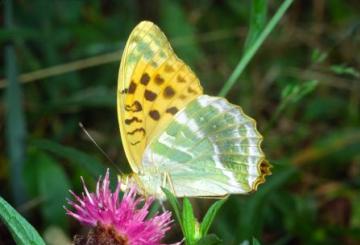Species Account for Argynnis paphia
Argynnis paphia (Linnaeus, 1758)
Silver-washed Fritillary
Lepidoptera: butterflies: Nymphalidae

Reproduction for study and non-profit use permitted, all other rights reserved.
Taxonomic group: butterflies (Lepidoptera: butterflies) - County data
View time series maps for Argynnis paphia
member log-on for taxon report
Images
upload a new image
Silver-washed Fritillary on UK Butterflies website
Species text
The largest of the British fritillaries and seemingly the least fussy in terms of habitat requirements, being able to utilise its larval host plant, Viola riviniana, growing in partial shade. Its recent expansion from its stronghold in the south-west of England has been remarkable. In 2003 it crossed the Chilterns into Hertfordshire and was first seen in Hatfield Forest in 2006. It reached Holt CP on the north Norfolk coast in 2010. Further Essex woodlands colonised include Marks Bushes (Harlow), Belhus Woods and Stour Wood. The reintroduction programme at the Marks Hall Estate could not have anticipated this natural expansion after many decades of absence. The cause of the spread in not known, but the most likely explanation is that climate change has created slightly warmer conditions on the woodland floor. This could have increased abundance at existing colonies, increasing the likelihood of dispersal to new woodland that has also become viable habitat. The Silver-washed Fritillary travels freely and can be seen almost anywhere, including gardens on warm days. It also utilises groups of small woodland and can exist at very low density over a wide area, such as at Epping Forest. References
Habitats
Why not join the Club, register and add a new species page
Interpretation of distribution maps























